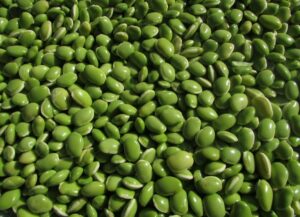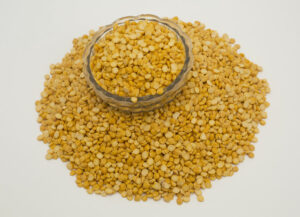Maria Villagrasa & Fernando Diaz
There is great reliance on soybean meal as the main source of protein in animal production, and as a result the animal feed sector is looking for protein alternatives with which to replace it. Blue lupins (Lupinus angustifolius) are a legume of Australian origin that could be an alternative protein source in animal production.
Lupinus is a very diverse and widespread genus in the Fabaceae family with numerous species. It is distributed over a wide range of climates, from the subarctic region to semi-desertic and subtropical climates, as well as from sea level to alpine ecosystems.
In Australia, where lupins are the most important legume crop, blue lupins account for 91% of the total Lupinus crop area, although they can also be found in northern Europe. The blue lupin is a sweet variety and its seeds have a high concentration of protein (30% dry matter, DM), unsaturated fat (5.5% DM) and soluble fiber (20% DM), as well as a high proportion of oleic and linoleic acids, and a very low concentration of starch.
Some varieties may have high concentrations of alkaloids (up to 2.0% DM), but in sweet varieties the average alkaloid content ranges from 0.02 to 0.05%. From this perspective, the blue lupin seeds of the Tango variety are those with the lowest alkaloid content (0.02%) so they may be a better alternative protein source in animal nutrition.
There is little information on the effects of blue lupin seed supplementation on the production and composition of cow’s milk. For this reason, a study (Bryszak et al., 2020) was carried out which, in addition to verifying these effects, also investigated how lupins affected the production of enteric methane, since in previous studies it had reduced it.
A total of 60 Friesian-Holstein cows in lactation were randomly assigned to two dietary groups:
- Control: total mixed ration (TMR) without blue lupin flour.
- TMR with blue lupin flour: 1 kg of wheat, 0.5 kg of oilseed flour, where 0.5 kg of soybean meal were replaced with 2 kg/day of lupin flour.
The diets contained grass silage, corn silage, beet pulp, brewers’ grains, wheat, cabbage flour and soybean meal as main ingredients of the TMR. The seeds of L. angustifolius Tango variety were dried and ground to obtain a flour with a nutrient composition of organic matter 96.5% DM, protein 34.5% MS, fat 4.00% DM, and neutral fiber detergent (NDF) 20.2% DM. The composition of the control diet with respect to that supplemented with lupin flour was on a DM basis: organic matter 91.6 vs. 91.6%, protein 18.9 vs. 18.5%, fat 3.15 vs. 2.66%, and NDF 35.5 vs. DM 38.1%.
Effects of lupin flour on ruminal parameters
The ruminal pH in the group of cows supplemented with lupins was higher than in the control group (5.89 vs. 5.79) which can be explained by the low starch content of the lupin seeds in turn associated with a low production of ruminal lactate, which can lead to ruminal acidosis.
The concentration of methane was lower in the treatment than in the control group (6.47 vs. 8.83 mmol/l ruminal fluid) and the population of total bacteria (12.4 vs. 3.80 x109/ml) and archaea (methane-producing bacteria) was also reduced (3.60 vs. 0.94 x109/ml) with supplementation, indicating that blue lupins have the potential to reduce methane production, in this case by reducing the population of ruminal bacteria that generate it.
Cows supplemented with blue lupins significantly reduced the concentrations of total volatile fatty acids (93.5 vs. 109.3 mM) and the ratio of acetic acid (47.1 vs. 48.7 mol/100 mol) compared to the controls, which may be due to a decrease in bacteria degrading cellulose. Moreover, the proportion of isobutyrate, isovalerate and valerate increased in the cows that received the supplement.
The ammonia concentration in ruminal fluid was higher in cows receiving lupin flour (8.45 vs. 5.37 mM) which can be explained by the rapid rate of degradation of the lupin proteins, an effect reported in other experiments.
Lupin supplementation caused the proportion of unsaturated fatty acids to increase
Milk production (32.4 kg), fat content (3.72%), protein (3.31%) and milk urea was similar in both groups. However, milk lactose concentration (4.92 vs. 4.83%) and solids non-fat (8.64 vs. 8.46%) were higher in the control group than the lupin-supplemented group.
These results are like those of other studies that could not find any effect of lupins on milk production. What this research shows is that both diets (control and supplemented with lupin flour) were balanced and covered the nutritional requirements of dairy cows.
However, since the body condition score was significantly higher in cows that received lupins compared to the controls (3.13 vs 2.87), it appears that the energy balance was better in the former.
With regard to the milk concentration of fatty acids, unsaturated fatty acids were higher in lupin-supplemented cows compared to the control group (32.1% vs. 31.1%), the same was true for the total omega 6 (5.22% vs. 4.93%) and omega 3 (0.47% vs. 0.42%) fatty acid concentrations.
Both acids are important components of cell membranes and are precursors to many other substances in the body, such as those involved in regulating blood pressure and the inflammatory response. Unsaturated fatty acids should be in the human diet, but the important thing is not so much the amount of each but their balance. In this study, changes in these two fatty acids significantly reduced the omega 6/omega 3 ratio (11.8 vs. 11.2) to one that would be beneficial to human health.
Conclusion
Supplementation with 2 kg/day of lupin flour to dairy cows did not affect milk production, however it improved their fatty acid profile by increasing the content of unsaturated fatty acids and decreasing the proportion of omega 6/omega 3 fatty acids. The addition of lupin flour also reduced methane production and increased ammonia concentrations.
These results suggest that supplementation with 10.0% DM of lupin flour could offer nutritional and environmental benefits to dairy production.
Reference
Bryszak, Magdalena & Szumacher-Strabel, Malgorzata & Huang, Haihao & Pawlak, Piotr & Lechniak, Dorota & Kołodziejski, Paweł & Yanza, Yulianri Rizki & Patra, Amlan & Varadyova, Zora & Adam, Cieslak. Lupinus angustifolius seed meal supplemented to dairy cow diet improves fatty acid composition in milk and mitigates methane production. Animal Feed Science and Technology 267 (2020) 114590.
© 2020 Dairy Knowledge Center. All Rights Reserved.









